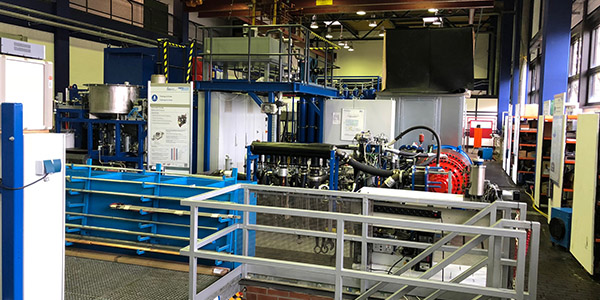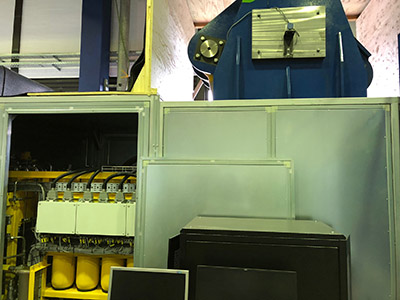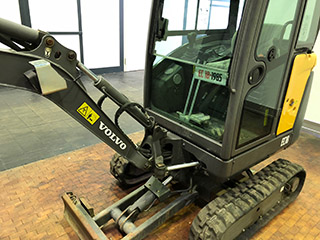 I had a very interesting tour of the IFAS (Institute for Fluid Power Drives and Systems) research labs, as part of the 11th IFK Fluid Power Conference in Aachen, Germany. IFAS, which is celebrating its 50th anniversary, is also undergoing a large change at the top, with a new leader.
I had a very interesting tour of the IFAS (Institute for Fluid Power Drives and Systems) research labs, as part of the 11th IFK Fluid Power Conference in Aachen, Germany. IFAS, which is celebrating its 50th anniversary, is also undergoing a large change at the top, with a new leader.
“It’s a very interesting time for the whole institute,” said Univ.-Prof. Dr.-Ing. Katharina Schmitz—incoming Executive Director of IFAS. The “official handoff and handshake,” as she put it, will take place on Wednesday evening, when longtime head Prof. Dr.-Ing. Hubertus Murrenhoff, will officially step down, after 24 years.
Arnav Ajmani, a member of the academic staff who is a relative newcomer to IFAS, led the tour and explained that the lab is currently home to 30 research assistants as well as about 70 additional students who also use the lab. Two years ago, a fire in an adjacent building caused damage to the lab that’s in the final stages of being rebuilt—they are hoping that everything will be back up to speed by November. Some portions of the lab, including an atmospheric/temperature chamber and an acoustic chamber, are still offline.
That said, there are a fascinating number of projects being worked on, many with major industrial partners like Ford Motor Company. Following are summations of some of the most interesting research areas:
 Marine wave energy test rig. This technology is still in the concept phase. Producing electrical power from ocean waves often involve oscillating buoyant bodies as energy converters—here, hydraulic cylinders attached to the wave energy converter (WEC) transfer the wave power into mechanical energy. A quarter-size mockup of a system towers over part of the lab and represents 1 MW of power. IFAS is focusing on efficiencies for the WEC, as well as the actual power take-off that would be used from the hydraulic cylinder to the electrical generator. Central to their system is an accumulator bank, which aids in power smoothing.
Marine wave energy test rig. This technology is still in the concept phase. Producing electrical power from ocean waves often involve oscillating buoyant bodies as energy converters—here, hydraulic cylinders attached to the wave energy converter (WEC) transfer the wave power into mechanical energy. A quarter-size mockup of a system towers over part of the lab and represents 1 MW of power. IFAS is focusing on efficiencies for the WEC, as well as the actual power take-off that would be used from the hydraulic cylinder to the electrical generator. Central to their system is an accumulator bank, which aids in power smoothing.- Dynamic damping. In conjunction with Ford, IFAS developed a test bench being used to investigate various types of vibration dampers, including the ability to characterize new types, as they are introduced. The test bench uses a hydraulic cylinder and piezoelectric force sensor, allowing for measurements of up to 10,000 N. For static loads, gas or pressure measurements are able to be carried out.
- Remote control teaching of pneumatics. A pneumatics lab was created to help new students with some of the fundamentals of fluid power. The number of students interested in studying this technology has been outpacing the hiring of new professors, so the Institute developed this test bench to demonstrate the fundamental functionality of pneumatic drive technology. This includes the dimensioning of drives and proper sequencing control.
- Railroad braking with hydro-mechanical closed-loop control. This project is looking into the development of a railway disc brake with a hydro-mechanical braking torque control. Hydraulic brakes are common local transport, thanks to their high force density and compact size compared to pneumatic brakes. On this design, any changes of the friction coefficient between the brake pad and disc—due to humidity, dust, or other environmental factors—can be compensated for, due to the closed-loop control.
- Pneumatic pressure booster. IFAS built a novel pneumatic radial piston motor and a radial piston compressor, to see whether an energy efficient local pressure boosting system was possible. The compressor is passively controlled by two check valves per cylinder connecting the chamber to the supply and outlet.
 Hydraulic hybrid system for excavators. Efficiency on mobile machinery is critical nowadays, thanks to fuel prices and ever-increasing demands made by environmental regulations. The STEAM system developed by IFAS is a holistic approach to both energy efficiency and performance. Volvo Construction Equipment is a partner here, and a prototype machine has been built that contains both a standard load sensing hydraulic system and STEAM. This way, objective comparisons can be conducted. STEAM thus far is showing a 30% increase in efficiency.
Hydraulic hybrid system for excavators. Efficiency on mobile machinery is critical nowadays, thanks to fuel prices and ever-increasing demands made by environmental regulations. The STEAM system developed by IFAS is a holistic approach to both energy efficiency and performance. Volvo Construction Equipment is a partner here, and a prototype machine has been built that contains both a standard load sensing hydraulic system and STEAM. This way, objective comparisons can be conducted. STEAM thus far is showing a 30% increase in efficiency.
Filed Under: News, Slider